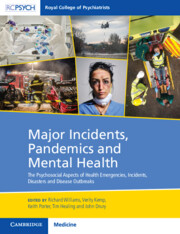 Major Incidents, Pandemics and Mental Health
Major Incidents, Pandemics and Mental Health from Section 6 - Designing, Leading, and Managing Responses to Emergencies and Pandemics
Published online by Cambridge University Press: 11 January 2024
This chapter collects lessons from the literature to outline the concrete steps necessary for organising and leading responses to emergencies, incidents, disasters, and disease outbreaks (EIDD). First, it summarises the common problems experienced in responding to EIDD. Second, it describes what steps should be taken at the policy level to prepare organisations for the challenges. Third, it outlines ways in which teams could be better organised to respond. Finally, it addresses the specific role of people who lead and manage EIDD in preparing their teams, developing capacity, and ensuring a collaborative emergency network. Although often separated into the different phases of preparedness, response, recovery, and rehabilitation, this chapter focuses on organisation and leadership in preparing for and responding to EIDD.
To save this book to your Kindle, first ensure [email protected] is added to your Approved Personal Document E-mail List under your Personal Document Settings on the Manage Your Content and Devices page of your Amazon account. Then enter the ‘name’ part of your Kindle email address below. Find out more about saving to your Kindle.
Note you can select to save to either the @free.kindle.com or @kindle.com variations. ‘@free.kindle.com’ emails are free but can only be saved to your device when it is connected to wi-fi. ‘@kindle.com’ emails can be delivered even when you are not connected to wi-fi, but note that service fees apply.
Find out more about the Kindle Personal Document Service.
To save content items to your account, please confirm that you agree to abide by our usage policies. If this is the first time you use this feature, you will be asked to authorise Cambridge Core to connect with your account. Find out more about saving content to Dropbox.
To save content items to your account, please confirm that you agree to abide by our usage policies. If this is the first time you use this feature, you will be asked to authorise Cambridge Core to connect with your account. Find out more about saving content to Google Drive.